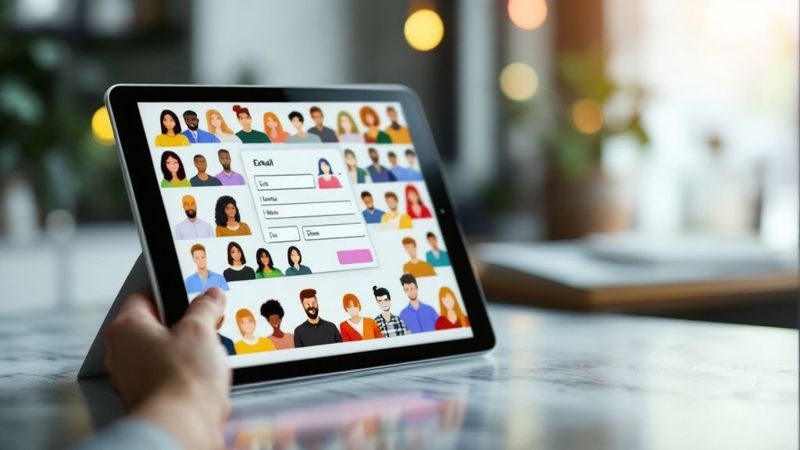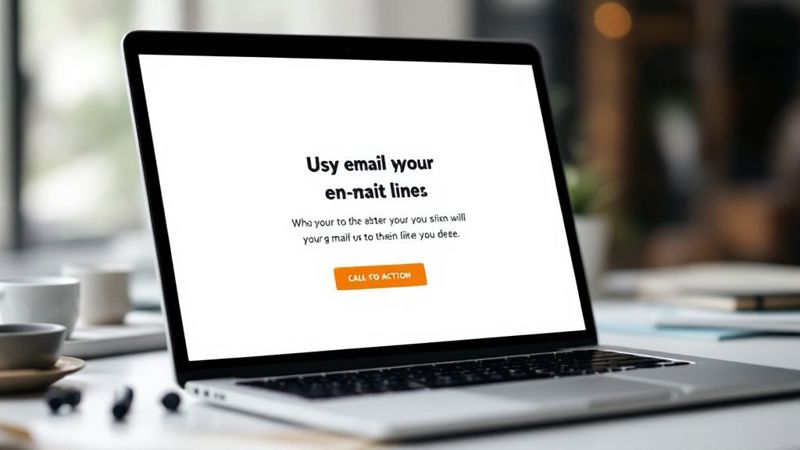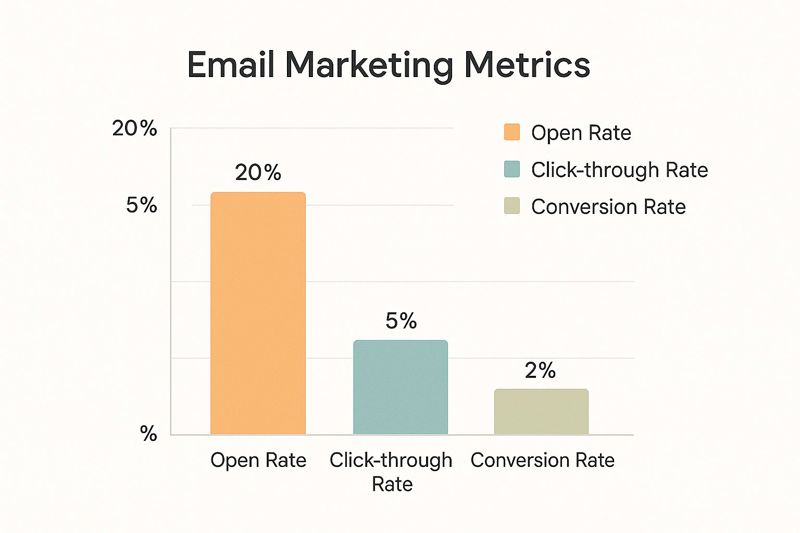To really make email marketing work for lead generation, you need a system. It's not about just sending emails; it's about building a machine that attracts prospects, nurtures them with valuable content, and converts them into paying customers. This means setting up an engaged email list, creating automated welcome sequences, and using dynamic, personalized content to make every single message feel like it was written just for them.
When you get this right, your email strategy transforms from a simple broadcast tool into a powerful, automated lead-generation engine that works for you 24/7.
Why Email Still Dominates Lead Generation

With all the noise about new channels, it’s easy to forget about email. But here's the thing: email marketing is still one of the most resilient and effective ways to generate high-quality leads. It gives you a direct line to your audience, far away from the chaos and unpredictable algorithms of social media.
Think of it this way: your social media following is like renting an apartment. The landlord (the platform) can change the rules, raise the rent, or even kick you out at any time. Your email list, on the other hand, is an asset you own. It's yours. This ownership gives you stability and total control over how you communicate, making it a reliable foundation for growing your business.
The Unmatched ROI of Email Marketing
The numbers don't lie. Email continues to prove its worth year after year. Marketers consistently rank it as a top driver of new business, and the financial returns are just too good to ignore.
A whopping 48% of marketers say email is their most effective tactic for lead generation, putting it ahead of both social media and paid search. The reason is simple: it delivers an incredible return on investment. For every $1 spent on email marketing, the average return is $36. You can dig into more email marketing statistics to see the full picture.
Email isn't just about sending messages; it's about starting conversations. When you treat each email as an opportunity to provide value, you build the trust necessary to convert a subscriber into a loyal customer.
Email Marketing vs Other Lead Generation Channels
It's helpful to see how email stacks up against other popular channels. Each has its strengths, but email's directness and ROI are tough to beat for nurturing leads over the long term.
| Channel | Average ROI | Primary Strength | Key Challenge |
|---|---|---|---|
| Email Marketing | $36:1 | Direct, owned audience; high personalization | Building a quality list takes time and effort |
| Content Marketing/SEO | Variable | Builds long-term authority and organic traffic | Results are slow; requires consistent effort |
| Paid Search (PPC) | ~$2:1 | Fast results and highly targeted traffic | Can be expensive; competition is high |
| Social Media Marketing | Variable | Brand building and community engagement | Algorithm changes; low organic reach |
While a multi-channel approach is always smart, email often serves as the central hub where you can nurture the leads you've gathered from other sources.
Shifting from Blasts to Personalized Journeys
Modern email marketing is a world away from the old "batch and blast" approach. Sending the same generic message to everyone on your list just doesn't work anymore. The key to success now is all about personalization and automation.
Instead of one-size-fits-all campaigns, smart marketers are focused on:
- Segmentation: Grouping subscribers based on their interests, how they signed up, or where they are in the buying process. A new lead needs a different message than a long-time customer.
- Automation: Setting up triggered email sequences that run automatically. Think welcome series for new subscribers or follow-ups for people who downloaded a resource.
- Dynamic Content: This is where it gets really powerful. Using a tool like OKZest, you can insert personalized images that change for each recipient, creating a truly one-to-one experience that grabs their attention.
This strategic shift is the difference between shouting at a crowd and having a meaningful, individual conversation. It makes your subscribers feel seen and understood, which is the first step to turning them into customers.
Building an Email List People Want to Join
If you want to generate leads with email marketing, you can't just slap a sign-up form in your website's footer and hope for the best. A high-quality email list is the engine that drives your entire strategy, and building one means giving people a genuinely good reason to subscribe.
The goal here isn't just about collecting contacts. It's about attracting people who actually want to hear from you. Trust me, a smaller, highly engaged list will run circles around a massive, indifferent one every single time.
Creating Irresistible Lead Magnets
A lead magnet is that free, valuable thing you offer in exchange for an email address. Its job is to solve a specific problem for your audience, giving them a quick win and an immediate taste of the value you bring to the table. Think of it as a friendly handshake that starts the relationship off right.
The best lead magnets are super specific and instantly useful. Forget about a vague "e-book." Get much more focused.
- Actionable Checklists: A "10-Point Website SEO Audit Checklist" is way more appealing than a generic guide on digital marketing. It gives someone a clear, tangible task.
- Exclusive Video Tutorials: Offer a short, high-impact video that teaches a specific skill, like "How to Set Up Your First Personalized Image Campaign in 5 Minutes."
- Industry-Specific Reports: A downloadable report like "The 2024 State of SaaS Email Engagement" immediately positions you as an authority and attracts serious professionals.
The trick is to align your lead magnet directly with your audience's pain points and what your business actually does. This way, the leads you attract are already warmed up and interested in your solution.
Optimizing Your Opt-In Forms for Conversion
Once you've got a killer lead magnet, you need to make it incredibly easy for people to get it. How you place and phrase your opt-in forms makes a huge difference. Ditch the boring "Subscribe to our newsletter" and use language that screams value.
Here’s a great example right on the OKZest homepage, inviting users to start for free.

This call-to-action focuses entirely on the user's gain—getting started with a powerful tool—which makes the decision to sign up feel like a no-brainer.
A powerful lead magnet doesn't just grow your list; it sets the tone for your entire relationship with a new subscriber. Deliver immediate value, and you'll earn their attention and trust from the very first interaction.
It's no surprise that lead generation is a top priority for 50% of marketers. But it can get pricey, with the average cost per lead hovering around $198.44. Considering that 41% of professionals rank email as their most effective lead generation channel, building a quality list is one of the smartest investments you can make.
For more inspiration, check out our guide on finding great ideas for a newsletter that will keep your new subscribers hooked from day one.
Crafting a Welcome Series That Builds Trust

That moment a new lead subscribes is your golden opportunity. Their interest is at its absolute peak, and they're literally waiting to hear from you. This is exactly why an automated welcome series is a non-negotiable part of any solid email marketing strategy. It’s your one shot to make a killer first impression and start building a real connection.
A well-planned welcome sequence does more than just say hello. It sets expectations, delivers instant value, and shows off your brand's personality. When you get it right, new subscribers feel seen and valued from the very first email. That immediate rapport is what turns a casual sign-up into a potential customer down the line.
The stats on this are pretty compelling. Welcome emails have an incredible average open rate of 83.63%, with automated workflows crushing the performance of standard one-off campaigns. That initial spike in engagement is a clear signal that your new leads are hungry for more. You can explore more data on the power of automated email campaigns to see just how big the impact can be.
Designing Your Three-Part Welcome Journey
I've found that a simple, three-email sequence is usually the most effective place to start. It gives you enough touchpoints to build familiarity without completely overwhelming your new lead. Each email in the series has a specific job, guiding the subscriber from initial curiosity to genuine interest.
Here’s a breakdown of a structure that just works:
Email 1: The Instant Value Delivery. This one needs to go out immediately after someone subscribes. Its main job is to deliver whatever lead magnet they signed up for and give them a warm welcome. Keep it short, focused, and genuinely helpful.
Email 2: The Brand Story. Sent a day or two later, this email is your chance to share what makes you unique. Tell a story, talk about your mission, or introduce the people behind the scenes. This is how you humanize your brand and build that emotional connection.
Email 3: The Next Step. The final email in the sequence, sent a few days after the second one, should offer another piece of value. This could be a link to your most popular blog post, a compelling case study, or an invite to a webinar. It reinforces your expertise and includes a soft call-to-action to keep them engaged.
This methodical approach nurtures the relationship step-by-step, making sure your brand stays top-of-mind.
Making a Memorable First Impression with Personalization
Using a subscriber's first name is a good start—it's table stakes these days. But you can go so much further. The real goal is to create a "wow" moment that makes your welcome email impossible to forget. This is where you can get creative and really change the game.
Your welcome email isn't just a delivery mechanism for a PDF. It’s the first chapter of the story you're telling your new lead. Make it personal, memorable, and genuinely helpful.
Imagine your first email not only addresses your new subscriber by name but also features a stunning, dynamically generated image. Tools like OKZest make this incredibly easy, letting you embed an image that says something like, "So glad you're here, Sarah!" right in the graphic.
This kind of visual personalization creates an immediate, powerful connection. It shows you’ve gone the extra mile and helps your brand pop in a crowded inbox. By combining a solid email sequence with dynamic, personalized images, you turn a standard welcome into an experience that builds trust and kicks your lead nurturing into high gear from day one.
Using Dynamic Images to Personalize at Scale
Let's be honest. Generic emails are the fastest way to get ignored, deleted, or marked as spam. If you really want to generate leads with email marketing, you have to move beyond just slotting in a subscriber's first name. True personalization creates an experience that makes each person feel like you're talking directly to them, and dynamic images are an incredible way to do this.
Instead of sending the same old static graphic to your entire list, imagine an email where the image itself is unique to the recipient. A B2B prospect could see an image featuring their own company logo. A real estate lead might get a picture of a house with their name on a "Welcome Home" sign. That's the kind of one-to-one customization that instantly grabs attention in a way plain text just can't.
This is a look at some of the typical benchmarks for email campaigns.

While these numbers are a decent starting point, dynamic personalization is how you really start to move the needle—especially on click-through and conversion rates that drive actual business growth.
Real-World Scenarios for Dynamic Personalization
So, how does this actually work in practice? By connecting a tool like OKZest to your email service provider, you can automate the creation of thousands of unique images, each tailored to the individual on your list.
Here are a few scenarios where this approach is a game-changer:
- Personalized Event Invites: Got a webinar coming up? Send an email with an image of a virtual ticket that has the subscriber's name and company printed right on it. Suddenly, the invitation feels exclusive and tangible.
- Dynamic Product Recommendations: An e-commerce brand could show a product image of a model wearing a shirt with the subscriber's name on it. It makes the item feel like it was custom-made just for them.
- Hyper-Personalized Demo Requests: A SaaS company sending a cold outreach email could include a screenshot of the prospect's website with a custom annotation, proving you’ve already done your homework.
Personalization isn't just a tactic anymore; it's an expectation. When you deliver a visual experience that is uniquely relevant to the recipient, you’re not just sending an email—you’re starting a meaningful conversation.
This strategy transforms a mass email into something that feels like a personal, one-to-one interaction. You can get more great ideas by exploring different strategies for using personalized images for email campaigns.
To really understand the advantage here, it helps to see how different tactics stack up. Basic personalization is good, but advanced visual personalization is where you see the most significant gains.
Impact of Personalization Techniques on Engagement
This table shows how different levels of personalization affect key email metrics, highlighting the advantage of advanced visual tactics.
| Personalization Tactic | Typical Uplift in Open Rate | Typical Uplift in CTR | Implementation Complexity |
|---|---|---|---|
| First Name Merge Tag | 5-10% | 1-5% | Low |
| Location/Company Name | 10-15% | 5-10% | Low |
| Dynamic Content Blocks | 15-20% | 10-15% | Medium |
| Dynamic Personalized Images | 20-30% | 25-50%+ | Medium |
As you can see, the jump in click-through rates with dynamic images is substantial. It proves that a visually relevant message is far more likely to drive action than a text-only approach.
The Impact on Engagement and Brand Loyalty
The effect of this kind of deep personalization goes way beyond a temporary spike in click-through rates. When subscribers see you've put in the effort to create content just for them, it builds a real sense of connection and trust.
This fosters genuine brand loyalty that keeps your audience engaged for the long haul.
By making your subscribers feel seen and valued, you create a memorable experience that cuts through the noise in a crowded inbox. It’s a strategic investment in building stronger, more profitable relationships with the people who matter most to your business.
How to Measure and Optimize Your Campaigns
Hitting "send" on your email campaign isn't the finish line—it's the starting block. The real work, the part that actually grows your business, begins when you start digging into the data to see what’s working and what’s falling flat. This is how you turn a decent campaign into one that consistently generates leads with email marketing.
It’s easy to get fixated on open rates and click-through rates. While they’re nice to look at, they don't pay the bills. They tell you people opened your email, not whether it actually convinced them to do anything. Real optimization means going deeper to understand the actual impact on your bottom line.
Key Metrics That Actually Matter
To get a true read on your campaign's health, you need to track the numbers that connect directly to lead generation and sales. These are the metrics that tell the real story.
I always tell my team to focus on these three core areas:
Conversion Rate from Email: This is the big one. It's the percentage of people who clicked a link in your email and then took the action you wanted them to—like booking a demo, downloading a guide, or buying a product. A strong conversion rate is a clear sign that your message and your offer are hitting the mark.
Lead Quality Score: Let's be honest, not all leads are created equal. A lead quality score helps you sort the hot prospects from the tire-kickers by looking at their engagement and other data points. This lets your sales team focus their energy where it’ll count the most.
Subscriber Lifetime Value (LTV): This metric calculates how much revenue a single subscriber brings in over their entire relationship with you. Knowing your LTV is crucial because it tells you exactly how much you can afford to spend to get a new lead. To really get a handle on this, check out this great breakdown on achieving high ROI with email marketing.
A Simple Framework for Continuous Improvement
Optimization isn't a one-and-done task. It's a constant cycle of testing, learning, and tweaking. The best way to do this? Good old-fashioned A/B testing. It's the most reliable way to figure out what your audience truly responds to.
Don’t just test to find a winner. Test to understand why you have a winner. Every test is an opportunity to learn something new about your audience, which makes your next campaign even stronger.
The key is to test just one thing at a time. This gives you clean, undeniable data. You could test two different subject lines to see which gets more opens. Or pit two calls-to-action against each other to see which gets more clicks. You can even test two versions of your personalized images to see which one drives more sign-ups.
By making this data-driven approach a habit, you build a repeatable process for getting better results. For a much deeper dive into the specific numbers you should be watching, check out our complete guide on essential email campaign analytics. It’ll help you turn that confusing spreadsheet of data into a clear roadmap for growth.
Even with the best-laid plans, a few questions always seem to pop up when you're focused on generating leads with email marketing. Let's run through some of the most common ones I hear, so you can move forward without any lingering doubts.
"Is It Ever Okay to Buy an Email List?"
This is a big one, and the answer is a hard no. I can't stress this enough.
Purchased lists are a cocktail for disaster. They’re packed with cold contacts who have no idea who you are and never asked to hear from you. Sending to a list like this is the fastest way to tank your sender reputation, rack up spam complaints, and watch your unsubscribe rates go through the roof.
There's only one sustainable way to do this: build your list organically. Offer valuable lead magnets, create great content, and earn your subscribers' trust. That’s how you build a list of people who are genuinely interested in what you have to say—the only kind of list that actually generates leads.
"What’s the Best Sending Frequency?"
Ah, the million-dollar question. There’s no magic number here. The right frequency depends entirely on your audience, your industry, and the kind of value you’re providing.
The real key is consistency and quality.
Some e-commerce brands kill it with daily deals, while many B2B companies find a weekly or bi-weekly cadence works best. A great place to start? Send one genuinely valuable email per week. From there, you can start testing and watch your metrics like a hawk.
Keep an eye on these:
- Open Rates: Are people still opening your emails, or are they starting to ignore you?
- Unsubscribe Rates: Is that number spiking after you increase the frequency? That's a bad sign.
- Conversion Rates: Most importantly, are more emails actually leading to more leads?
Let the data be your guide. If engagement drops, you're probably sending too often. If it holds steady or even ticks up, you’ve found a rhythm that works.
The right email frequency isn't about how often you can send. It's about how often you can send something your audience actually wants to read. Always prioritize quality over quantity.
"How Do I Re-Engage Inactive Subscribers?"
Every email list has them—the subscribers who signed up with enthusiasm but have since gone quiet. Before you hit the delete button, it’s always worth running a re-engagement campaign to try and win them back.
Think of it as a short, targeted sequence designed to get their attention one last time.
Kick it off with a direct subject line that acknowledges their absence, something like "Is this goodbye?" or "We miss having you around." In the email, remind them what they're missing out on and give them a compelling reason to stick around. An exclusive discount, a sneak peek at a new resource, or a simple "click here to stay subscribed" can work wonders.
If they still don't bite after a few attempts, it’s time to say goodbye. Removing them from your active list is just good list hygiene and helps protect your deliverability.
Ready to create emails that grab attention and won't be ignored? OKZest makes it easy to add dynamic, personalized images to your campaigns, turning every message into a unique experience. Start creating for free at OKZest.com.